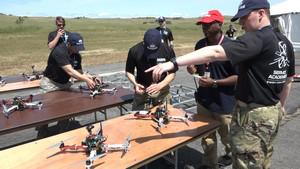DronesService Academies Swarm Challenge: Controlling drone swarms
UAVs and other robots have become increasingly affordable, capable, and available to both the U.S. military and adversaries alike. Enabling UAVs and similar assets to perform useful tasks under human supervision — that is, carrying out swarm tactics in concert with human teammates — holds tremendous promise to extend the advantages U.S. soldiers have in field operations. A persistent challenge in achieving this capability, however, has been scalability: enabling one operator to oversee multiple robotic platforms and have them perform highly autonomous behaviors without direct teleoperation. To help make effective swarm tactics a reality, DARPA created the Service Academies Swarm Challenge, a collaboration between the Agency and the three U.S. military Service academies.

Military service academies compete to develop a platform for offensive and defensive swarm control // Source: theconversation.com
Small unmanned aerial vehicles (UAVs) and other robots have become increasingly affordable, capable, and available to both the U.S. military and adversaries alike. Enabling UAVs and similar assets to perform useful tasks under human supervision — that is, carrying out swarm tactics in concert with human teammates — holds tremendous promise to extend the advantages U.S. soldiers have in field operations. A persistent challenge in achieving this capability, however, has been scalability: enabling one operator to oversee multiple robotic platforms and have them perform highly autonomous behaviors without direct teleoperation.
DARPA says that to help make effective swarm tactics a reality, DARPA created the Service Academies Swarm Challenge, a collaboration between the Agency and the three U.S. military Service academies — the U.S. Military Academy, the U.S. Naval Academy, and the U.S. Air Force Academy. An experiment at its heart, the research effort is designed to encourage students to develop innovative offensive and defensive tactics for swarms of small UAVs. Today the effort started its three-day Live-Fly Competition at Camp Roberts, a California Army National Guard post north of Paso Robles, California, which is hosting more than forty Cadets and Midshipmen to demonstrate the highly autonomous swarm tactics they have developed since work started in September.
“In less than eight months, you have shown yourselves to be dedicated and talented participants in a complex and timely research effort,” Timothy Chung, the DARPA program manager leading the Swarm Challenge, told the teams. “DARPA is proud to have you — our future warfighters and Service leaders — participating in this endeavor to explore offensive and defensive swarm tactics. Now is your chance to show each other, DARPA, and our invited Defense Department guests your precedent-setting work toward an important goal: helping future U.S. forces maintain superiority in tomorrow’s technological and mission environments.”
“Not to mention your chance to claim bragging rights over your rival academies,” he added.
Teams
DARPA notes that the Service Academies Swarm Challenge is the most recent example of how DARPA works to ensure the technological superiority of U.S. military forces by periodically engaging the U.S. military Service academies in research-oriented competitions. These competitions aim to cultivate the great potential of young officers-to-be and encourage their career-long collaboration with DARPA. In both 2014 and 2015, for example, DARPA conducted the DARPA Service Academy Innovation Challenge and the Service Academies Cyber Stakes.
